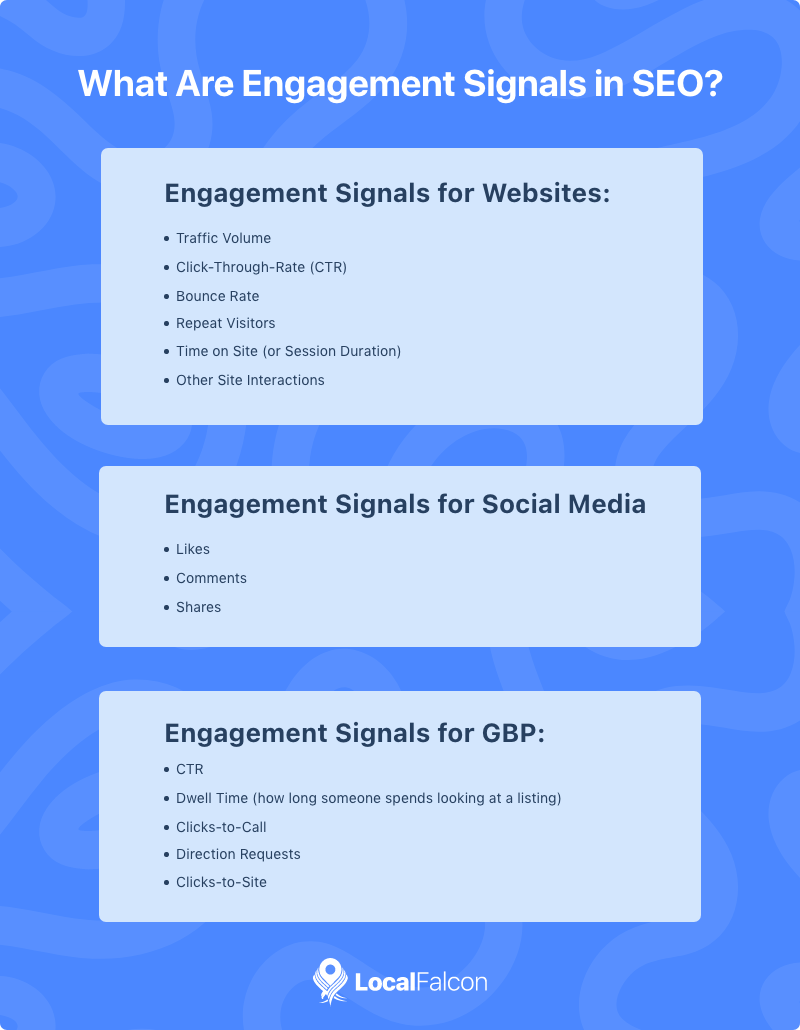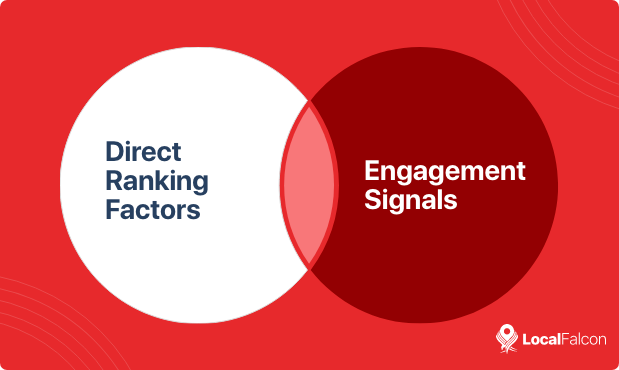When we talk about local search ranking factors, we often focus on factors that directly affect local rankings, such as Google Business Profile categories, reviews, and business information. But engagement signals are another important type of ranking factor that shouldn't be overlooked when you're doing local SEO for any type of business.
What Are Engagement Signals in SEO?
In SEO, the term "engagement" refers to how users interact with your online assets, whether it be your Google Business Profile, website, or social media channels.
For example, a user clicking on a business's Google Business Profile reviews to expand and read them is a type of engagement.
On social media, someone liking, sharing, or commenting on a post are all examples of user engagement.
For websites, users clicking through to different pages and spending time reading articles or other content are examples of engagement.
There are many different ways that users can engage with a business online, and not all of them matter for SEO, but there are certain types of engagement that search engine algorithms do pay close attention to and factor into their rankings. These are engagement signals, or engagement-related ranking factors.

All of the Following Are Engagement Signals for Websites:
- Traffic Volume
- Click-Through-Rate (CTR)
- Bounce Rate
- Repeat Visitors
- Time on Site (or Session Duration)
- Other Site Interactions
All of the Following Are Engagement Signals for Social Media:
- Likes
- Comments
- Shares
All of the Following Are Engagement Signals for GBP:
- CTR
- Dwell Time (how long someone spends looking at a listing)
- Clicks-to-Call
- Direction Requests
- Clicks-to-Site

What's the Difference Between Direct Ranking Factors and Engagement Signals and Why Should You Care?
As their name implies, direct ranking factors directly affect your search rankings. For instance, if a business changes its primary category on Google Business Profile from "heating contractor" to "air conditioning contractor," Google is going to quickly start ranking them higher in air conditioning-related searches and lower in heating-related searches.
Google reviews are another example of a direct ranking factor that's important in local search. The more reviews you have and the better they are, the higher your business is going to rank on Google.
In this sense, direct ranking factors are easy to understand and optimize for because no matter how users engage with your profile, they are always going to have some type of direct impact on your rankings.
But Google and other search engines also take engagement into account when determining rankings, so it's important to understand how engagement signals for SEO work and how to improve them.
For example, a Google Business Profile that users spend a lot of time on reading through information, looking at photos and videos, and then clicking to call the business or get directions to it is going to have an advantage over one that users just look at for a couple of seconds before moving on.
This is why it's so important to not only make sure you're checking all the boxes when it comes to direct ranking factors, but also make sure you're providing the best user experience possible to improve engagement signals.
Improved engagement signals show search engines that users recognize and value your business and its offerings, and they'll reward this with better rankings in the SERPs.

How Can You Improve Engagement Signals for Local SEO?
In the world of local search engine optimization, you want to work on improving user engagement for both your Google Business Profile and your business site to help boost your rankings. Here are a few tips on how to do so.
Improving Engagement Signals for Your GBP Listing
Improving Google Business Profile engagement starts with completing your profile as much as possible, filling out all relevant business information and not leaving anything blank if possible.
Think about it; if you search Google or Google Maps for "shawarma near me" and you click on a listing only to discover that it doesn't include much more information than a business name and an address, you're probably going to quickly click on a different listing to find a business with more complete information to help you make your decision about where to go for lunch.
Users are much more likely to spend time looking at and interacting with a GBP listing that has all fields filled out and includes a detailed business description, business hours, photos and videos, and additional features.
Enabling features like direct calling, booking, or food ordering can also help improve your GBP's engagement signals, giving users more options to click on than just the "directions" button, not to mention these features can help you convert more leads into customers!
Improving Engagement Signals for Your Business Website
As for improving engagement signals for your website, you'll want to ensure first and foremost that you're providing an excellent user experience. This includes fast page load times, mobile responsiveness, and an intuitive, user-friendly design.
Beyond that, you should include plenty of information that's actually helpful to users, which will encourage them to spend more time clicking through to different pages and reading the content on your site.
For example, a dentist might publish helpful blog articles that align with local search intent, providing relevant information around common search queries like, "do root canals hurt?" or "what are the different types of dental implants?"
Then, when a potential customer comes across these articles in search results, they'll be more likely to click through to the site (improving click-through-rate) and stay on it reading the information (improving session duration), contributing to better overall engagement signals.
These improved engagement signals show that your site is providing both a good experience and value to users, which can help boost its position in search results.
Wrapping Up
Engagement signals are an important aspect of SEO to understand, affecting both organic and local SEO.
When you optimize to improve engagement signals alongside direct ranking factors, the result is a well-rounded SEO strategy that provides an excellent user experience, builds trust with your target audience, and ultimately boosts your search rankings!


